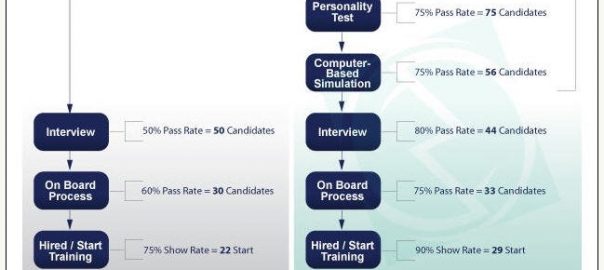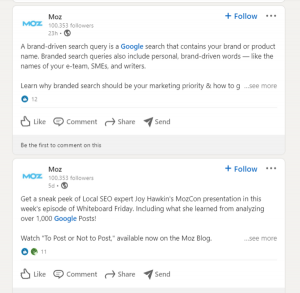Can you have both quality of hire and recruiting speed in the hiring process?
Recruiting speed and hiring for quality are two of the biggest challenges facing firms that employ contact center agents. By quality of hire, we mean the organizational standard that defines satisfactory job performance. By recruiting speed, we mean how fast the hiring process can move a candidate from point of contact to an accepted job offer.
Correlation between speed of hire and quality of hire
Though the economic downturn has seen increased unemployment and created more job candidates seeking work, these challenges still remain. FurstPerson’s 2009 Call Center Recruiting and Compensation Survey found that many call centers expect to increase hiring in 2010. And, a recent research article (HT – Bryan Baldwin) published in Personnel Psychology (“The Effect of Job Offer Timing on Offer Acceptance, Performance, and Turnover” by William Becker, Terry Connolly, and Jerel Slaughter) discusses how job offer timing can impact job acceptance. The article reminds us of the constant challenge to link speed of hire with quality of hire. Even with significant unemployment, the challenge stills exists to find individuals who can be successful working in a contact center. The goal is to avoid the high risk area of slow recruiting speed and low quality of hire.
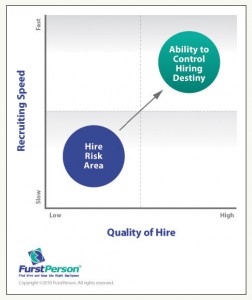
Why does quality of hire and recruiting speed matter?
Why does quality of hire and recruiting speed matter? Several years ago we highlighted research from the Aberdeen Group, plus our own data, on the cycle time for hiring hourly workers. As the chart below shows, the best qualified candidates tend to find jobs within 5 days. As the recruiting speed slows, the labor pool of higher-quality candidates sourced for this position will shrink.
Similarly, the Becker at al. article found that job offer timing can impact overall job acceptance. While the study did not review hourly workers, their research concluded that job seekers are more likely to accept employment offers made earlier in the company’s hiring process than later. In other words, extending the offer as soon as possible is better than waiting.
If You Identify How Job Candidate Met Quality of Hire Requirements Quickly, You Have the First Choice of Candidates
Contact centers lacking competitive hiring processes risk losing job candidates to those organizations that can define and identify high-quality candidates quickly and have a faster recruiting speed, allowing them to present the offer as soon as possible in the process. Looking at it another way, as the chart below demonstrates, if your recruiting organization can identify how the job candidate meets your quality of hire requirements and do it quickly, you have the first choice of candidates. If not, you may be faced with candidates that don’t meet your performance standards. Think of trying to make as many first round draft picks as possible versus later round draft picks.
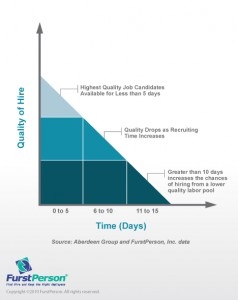
Leading contact centers achieve fast recruiting speed and quality with Predictive Hiring Processes
Leading contact centers achieve fast recruiting speed and quality of hire evaluations by pushing proven (i.e. predictive) hiring processes into automated, objective systems that are calibrated against key performance outcomes and link into an integrated employee lifecycle. These organizations do this by leveraging the following:
- They use a quantifiable job analysis process to systematically identify the key knowledge, skills, abilities, and behaviors (competencies) associated with the job in order to perform satisfactorily. This enables the hiring team to target who they want to hire.
- Based on the job analysis, they use assessment tools before an interview to qualify the job candidate.
- The assessment tools, which include work samples, problem solving assessments, and personality tests, are calibrated against specific job performance results so that an objective and predictive pass/fail decision can be applied automatically against each candidate.
- They understand that in hiring for a contact center, assessment tools tend to be more predictive at measuring job performance than the results of a traditional interview. They are certainly much better than traditional screening questions like education, work history, and other standard knock-out questions.
- Since recruiting is (and should be) a contact sport, the interview is structured and based on the job analysis. The goal of the interview is to reduce variance and structure it so that it is predictive of some job performance. Because candidates have been filtered, recruiters can focus on the better qualified candidates, saving them significant administrative time.
- The entire process is web-enabled and linked to key performance systems, which means the process gets smarter as time goes on.
Traditional Hiring Process vs Technology & Data-Driven Hiring Process
The example below compares two hiring processes. The first, on the left, uses a traditional application process and interview process. The second, on the right, uses a more automated model incorporating assessments to evaluate job candidates before they are introduced to the recruiting organization.
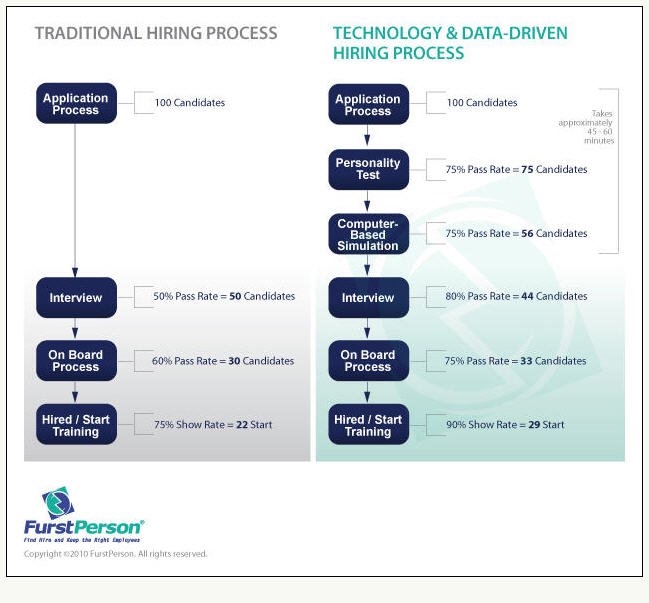
Benefits of Using a Technology & Data Driven Hiring Process – Lower Costs, Faster Speed and Higher Quality
In the traditional model, recruiters need to speak with all 100 candidates. However, recruiters in the model on the right will only need to speak with 56 candidates because 44 have been eliminated by the assessment tools which measure job fit and work abilities (multi-tasking, computer ability, accuracy with information, etc.). Assuming that the interview process is approximately 40 minutes, the recruiters on the right save about 30 hours per 100 candidates. In addition, the assessment tools help to filter through the best candidates, improving the overall quality of hire. This leads to increased success during the on-boarding process and a higher percentage of show rates for training. The net result is a lower cost per hire, better quality of hire, and faster recruiting speed.
Candidate Qualification Processes Improve Overall Hiring Speed and Quality of Hire Accuracy
In summary, hiring hourly workers in customer contact positions will always be challenging. Contact centers that understand their recruiting processes and candidate qualification processes can make the right changes to improve overall hiring speed and quality of hire accuracy. This can create a significant competitive advantage in the local labor market as well, by getting the right talent into your organization faster.
Image courtesy of FreeDigitalPhotos.net
Business & Finance Articles on Business 2 Community
(87)
Report Post